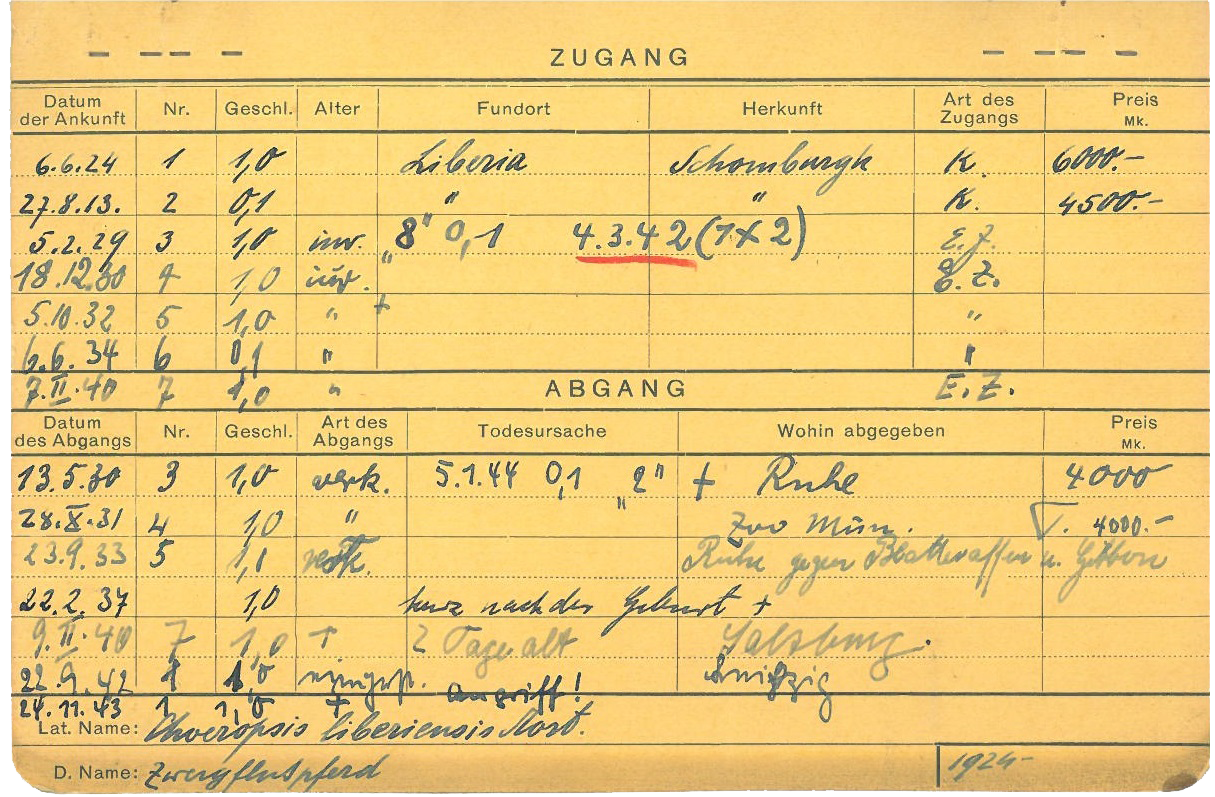
Steinmetz index card on pygmy hippopotami, around 1935. (AZGB. All rights reserved.)
The  index card shown is from Berlin Zoo’s Steinmetz Index and records the number of pygmy hippopotami (Choeropsis liberiensis) the zoo held. The initial entry indicates Berlin’s first pygmy hippopotamus,
index card shown is from Berlin Zoo’s Steinmetz Index and records the number of pygmy hippopotami (Choeropsis liberiensis) the zoo held. The initial entry indicates Berlin’s first pygmy hippopotamus,  purchased from Hans Schomburgk. In zoology, ‘1,0’ denotes a male, ‘0,1’ a female. The Latin abbreviation ‘iuv.’ signifies a young animal. ‘K’ indicates ‘Kauf’, a purchase and ‘E.Z.’ indicates ‘eigene Zucht’, a bred animal – that is, an animal born in a zoo. The index card also gives the name of the trader: the animal was delivered to the company Ruhe in Alfeld for the price of 4,000 German marks.
purchased from Hans Schomburgk. In zoology, ‘1,0’ denotes a male, ‘0,1’ a female. The Latin abbreviation ‘iuv.’ signifies a young animal. ‘K’ indicates ‘Kauf’, a purchase and ‘E.Z.’ indicates ‘eigene Zucht’, a bred animal – that is, an animal born in a zoo. The index card also gives the name of the trader: the animal was delivered to the company Ruhe in Alfeld for the price of 4,000 German marks.
Notably, the recorded departures indicate that individual animals were exchanged with other zoos. The index card also shows that during the war, a male was evacuated to Leipzig Zoo, which was supposedly bombproof. The word ‘attack’, in turn, tells us that that first hippopotamus, acquired from Hans Schomburgk in 1924, was killed in the  bombing of Berlin on 24 November 1943.
bombing of Berlin on 24 November 1943.
This index was probably created by the zoologist Hermann Steinmetz (1898-1954), who worked as a senior assistant at Berlin Zoo in the 1930s. In the last days of the liberation of Berlin, he fled the city with zoo director  Lutz Heck. Steinmetz was the first director of the Ruhr Zoo in Gelsenkirchen from 1948 onwards.
Lutz Heck. Steinmetz was the first director of the Ruhr Zoo in Gelsenkirchen from 1948 onwards.
During his time at Berlin Zoo, Steinmetz kept this  index, which zoo staff subsequently dubbed the Steinmetz Index. The index sometimes contains more detailed information on individual animals than the annual zoo inventory kept in the
index, which zoo staff subsequently dubbed the Steinmetz Index. The index sometimes contains more detailed information on individual animals than the annual zoo inventory kept in the  ‘Journale’ since the 1880s, for example on the reasons for an animal’s departure, whether through exchange, sale, or death, and whether a new arrival was in the form of a gift, purchase, or birth. Both the Steinmetz Index and the ‘Journale’ were for internal use at the zoo only, while other media such as the journal
‘Journale’ since the 1880s, for example on the reasons for an animal’s departure, whether through exchange, sale, or death, and whether a new arrival was in the form of a gift, purchase, or birth. Both the Steinmetz Index and the ‘Journale’ were for internal use at the zoo only, while other media such as the journal  “Der Zoologische Garten” published zoological and veterinary articles.
“Der Zoologische Garten” published zoological and veterinary articles.
Because individual cards consolidate information spanning several years, the index provides zoologists at the zoo and external researchers with a real advantage, as it makes it possible to trace how long each individual animal had been kept at the zoo and its lifespan. The card index was not maintained after Hermann Steinmetz left, and thus represents only a snippet of Berlin Zoo’s 175-year history.
Nowadays most German zoos use the Zoological Information Management System software, or  ZIMS for short, to record arrivals and departures, as well as information on births. Berlin Zoo nonetheless continues to maintain the physical journals as a parallel reference system.
ZIMS for short, to record arrivals and departures, as well as information on births. Berlin Zoo nonetheless continues to maintain the physical journals as a parallel reference system.